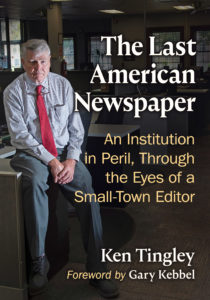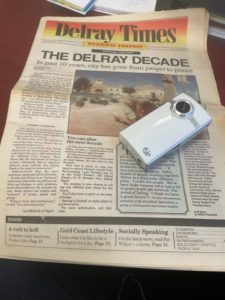
Ken Tingley has written a love letter to the local newspaper.
A few weeks back, I wrote about cleaning out a junk drawer and finding an old Delray Times newspaper from 1995.
I worked for that paper for about a decade from 1987 to 1996 when I left to start my own education newspaper.
I’ve been blessed with a lot of interesting and great jobs/roles in my life, but none better than being a reporter for the old South Florida Newspaper Network.
It wasn’t the pay (we made very little money).
It wasn’t the perks. (There were none unless you count free parking).
It was the people and the job itself.
Newsrooms attract funny, smart, talented, creative, and idealistic souls. It was a joy to work with them in a wide-open office where every day was an adventure.
You get to hear about the interesting stories your colleagues are working on, the colorful characters they are chasing and the “you can’t make this stuff up” things you see when it’s your job to report what’s going on in town.
I know it’s fashionable to bash the press these days. “Fake news” is the latest adorable saying meant to undercut the credibility of the only industry protected by our Constitution. It is protected because a free press is essential to a Democracy.
I’ve been on both sides of the pen so to speak. I spent years as a journalist covering people making news and I’ve been written about, which is far less fun.
I’ve seen amazing reporters and I’ve seen some bad ones, but there’s no doubt in my mind that a free press keeps us a free people.
I’ve been thinking about the role of local newspapers a lot these days.
When I moved to South Florida in 1987, Delray Beach was covered by four newspapers: The Sun-Sentinel, The Palm Beach Post, The Boca Raton News and the Monday-Thursday Papers (my alma mater and the precursor to the South Florida Newspaper Network). On big stories, the Miami Herald came to town.
You had to work hard not to know what was going on in Boca and Delray.
And the level of coverage spurred civic engagement. More people voted. More people attended Commission meetings (they weren’t at 4 p.m. when anyone who works can’t attend) and more people volunteered because they knew what was going on and when you know what’s happening, you’re more likely to want to be involved.
Everyone knew their city commissioners, county commissioners, school board members and state legislators. They attended charettes and visioning conferences, they showed up to protest or support projects and they relied on the local papers for information. In other words, there was a community ‘water cooler’ and local reporters competed fiercely for readers, so you saw a lot of “enterprise” reporting not just dry meeting coverage.
In hindsight, it was a golden age. Not only for newspapers but for civic engagement. We never thought it could end.
But it did.
Not with a big crash, but with a slow-motion agonizing fade that saw newspapers shrivel up, or in the case of the Boca News—die. Even the vaunted Monday-Thursday Papers went away.
My friends in community journalism found other careers in public relations, marketing, advertising and sometimes in fields that had nothing to do with writing or communications. One former senior newsroom guy that I knew, ended up living in his car in a Boca Raton parking lot. The last time I saw him, he had his arm broken by someone who tried to rob him while he slept. We met and he was offering to sell me memorabilia from his career. It was a sad and terrible end to what had been a good run.
But as much as the people in the field suffered and were forced to reinvent themselves, the communities they covered suffered as well and continue to pay the price.
Today, there is no water cooler.
We have Facebook which often spreads misinformation, one monthly newspaper that has an odd bent (in my opinion), a few lifestyle magazines, a few newsletters (one is anonymous which undercuts its credibility) and a podcast or two with limited audiences.
We are poorer because our newspapers have gone away. The Sun Sentinel and Palm Beach Post are sad shells of their past versions, and the few reporters around don’t seem to have any history in our community. We lose something real and valuable when institutional memory becomes forgotten history. Coverage suffers without context; it’s like coming into a movie that’s half over and pretending to know the plot.
I recently finished a wonderful book called “The Last American Newspaper” by Ken Tingley. It’s a poignant book that tells the sad story of The Post-Star, an award winning newspaper in Glens Falls, N.Y.
The paper was a local powerhouse and even won a Pulitzer Prize for its editorials, an almost unheard-of victory for a small newspaper.
But the Post-Star was ambitious and committed to the community it served for over a century. The newsroom—led by Mr. Tingley— reported the news fairly and accurately, surfacing important issues from teenage drinking and domestic violence to homelessness and the financial troubles of the local hospital, which also happened to be a major advertiser.
Because the Post-Star did its job so well, the paper sparked important conversations that often led to meaningful change.
But over time, as the Internet came to dominate, the Post-Star lost revenue and no longer had the resources to produce the in-depth journalism that communities need to thrive.
The diminishment of local journalism is an important issue that needs to be addressed by every community in America. But especially here, in fast moving complicated South Florida.
I’ve long believed that it is easier to find out what is going on in Kabul, than it is to find out what’s happening at City Hall. That’s not good if you value community and if you care about your tax dollars.
Rogues thrive in the darkness where brave reporters once shined a light.
I don’t have any answers. In my opinion, nobody does.
I keep tabs on my old profession and see a few promising seeds: local newsletters that sell subscriptions, online newspapers, city-oriented podcasts etc. But there’s nothing like a newspaper. The magic of opening something you can touch and discovering something interesting and noteworthy.
We will lose a lot when the last newspaper vanishes. We already have.

